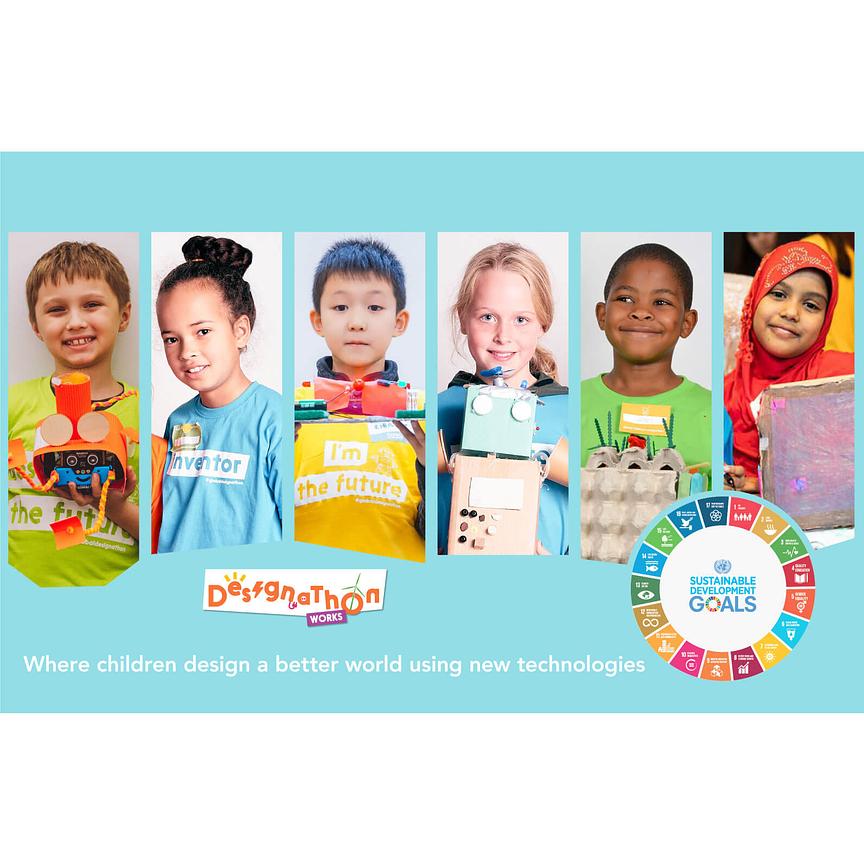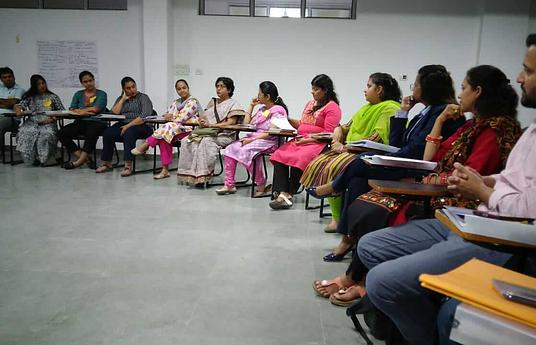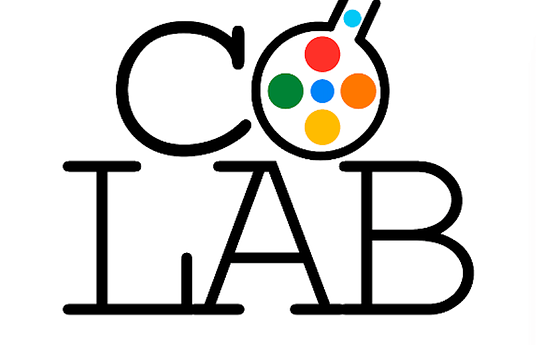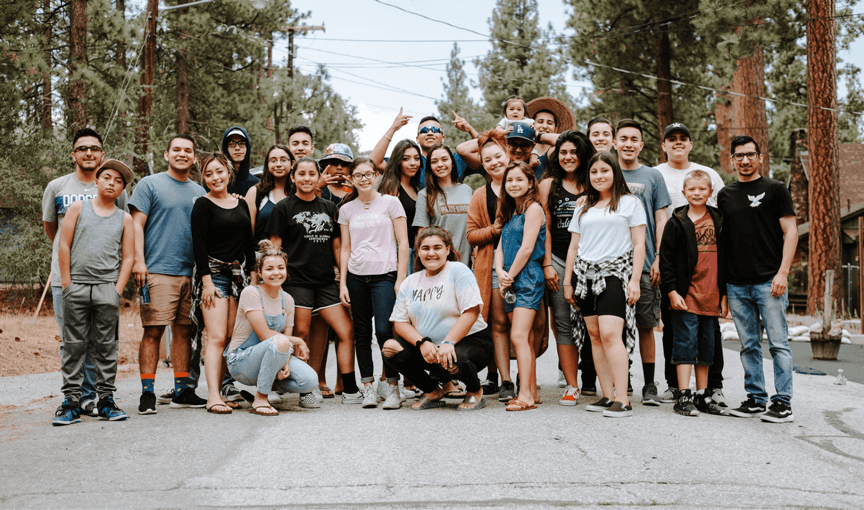Worldwide there are 2 billion children of school-going age. What if we all saw children as creative changemakers, engaged humans, scientists and inventors? What if we then helped them to develop those abilities?
For 7 years Designathon Works has been advocating for a radical rethink on how society and education systems see children. We do so by working with teachers, parents and after-school educators, helping them to grow their creative mindset and in turn enable the next generation of changemakers!
Surprisingly to many adults and teachers when children are asked what change they would like to see in the world, they don’t ask for less homework and more sweets. In fact, they want to cure cancer, remove plastic from the ocean or tackle world hunger. A few examples of what children have come up with during designathons include:
- Nairobi: a special set of traffic lights to tackle drunken drivers. (SDG 10)
- Amsterdam: a supermarket robot to teach shoppers how to switch to plant-based food, in order to reduce CO2 emissions from meat. (SDG 12,13)
- Kathmandu: a solar-powered community fridge to share food with those in need. (SDG 2,13)
- Rotterdam: a campaign against child poverty. (SDG 1)
Children reached
Our organization has already reached more than 100,000 children, trained over 500 teachers and inspired another 1100 educators through introduction workshops. Our method is designed to work with children of all backgrounds and capacities and therefore is inclusive. The method focuses on building the inner capacities of all children, regardless of their gender, race, class, skill or learning situation. It recognizes that all children can and want to contribute. A few examples of the diversity of the children we work with include children growing up in the slums in Nairobi (Mukuru kwa Reuben), newcomer children in their first year in the Netherlands, gifted children at The Day a Week School in Amsterdam and children in Shanghai, China who have won the Shanghai Science fair competition. We are convinced that all children benefit from developing skills such as creative & critical thinking, changemaker skills, technological literacy and global citizenship.
The Designathon Method
The Designathon method combines aspects of Design Thinking and Maker Education. A designathon is a structured workshop in which children (ages 8 - 12 years) ideate, build and present their self-devised solutions to a social or environmental issue around the Sustainable Development Goals. The programs vary from one-day workshops to 10-week school programs and are facilitated by education professionals. The experience helps children practice and apply their creative thinking, changemaker skills, technological literacy and intercultural awareness. The power of the method lies in the combination of scientific knowledge, creative thinking, world problems, collaborating, making things and reflecting.
Design thinking and maker education tools for student and teacher
The steps in the method are: ‘Inspire, Research, Ideate, Sketch, Make, Present and Reflect’.
Each step has user-friendly tools for both the student and the teacher. The tools for the students are to help them to do the ‘Research’ such as interview formats and empathy maps, for the ‘Ideate’ step there is a theme-specific ideation worksheet to guide them in choosing a problem within the theme, coming up with ideas and choosing the team’s preferred idea, the sketch worksheet has tips. For the ‘Make’ step there are material lists for recycling materials to collect and a special maker kit with motors, LEDs and switches plus video tutorials on how to mount them. For the present and ‘Reflect’ steps there are sentence supports, tips for giving other teams constructive feedback and suggested reflection questions.
For the teacher, there is a project guidebook including facilitation tips per step and an opening lesson per theme (SDG) for the 1st ‘Inspire’ step. The ideation worksheet has a teacher’s version with prompts for the teacher on how to facilitate the children’s emergent ideas. The teacher also has a list of criteria to check with the children on how to assess their idea (and later their prototype) and improve it.
All materials are user-friendly and downloadable via our platform. New themes (SDGs) are added regularly.
Each new theme or project is tested, and improved and then localized (including language translation) with our network partners
In 2019, we added an 'action phase' to the Designathon method with children making plans for individual practical action alongside their team's prototype. This has led to children teaching other children about food waste, making campaigns in their schools to convert to solar energy, making cards for their elderly neighbors during corona and sharing seeds to grow vegetables with other families.
Contextualising the SDGs
In each SGD or theme such as Clean Water for All, Food and Climate Action or Mobility in CIties, the children have the opportunity to self-contextualise the thematic area by identifying the problem within the theme that they want to tackle. For example on the theme of mobility which includes issues such as the environment, safety and access to mobility children in Amsterdam often elect to tackle traffic jams or CO2 while in Nairobi the children choose issues such as drunken drivers or costs of travel.
How is our method different?
The Designathon method is different from other existing education methods because:
- A designathon is a structured process with an open-ended assignment on the SDG's, the method promotes student agency as proposed in the OECD 2030 Future of Education and their Learning Framework 2030;
- The children not only gain knowledge on the topic, but also a big variety of 21st-century skills (such as: creative thinking, complex problem solving and global citizenship, as mentioned in the WEF Future of Jobs Report) and empowerment to take action in whatever shape or form they feel best;
- It works with various groups of children despite their socio-economic background, ability or country. The method is inclusive by design because children are invited to start the Designathon process at their own level (skills, knowledge). Furthermore, the themes include both local and global information and can be contextualized.
Our teacher training is focused on discovering the teacher's own agency and ability to empower the creativity of children (see our other page).
Global Children's Designathon
While most of our work is through training teachers to run the program in their own classrooms or after-school programs, our flagship event is the annual Global Children’s Designathon. During which, children in 40+ cities worldwide work in parallel to design and develop innovative concepts around the Sustainable Development Goals. Through the Designathon method, they develop their own ideas, design and build prototypes, and exchange their ideas with their peers, experts & professionals.
After each edition, we collect the best 3 designs from each city, do research on the impact and present our findings at world fora such as the WEF Future Councils.
The impact of learning
During the last three editions of the Global Children's Designathon, we conducted research into the impact of the event on the children and to learn more about the concerns of the children in relation to the theme. We presented the findings in three research reports called 'Global Voices of the Next Generation'. In 2019, children indicated that their primary motivation to participate in the event is based on the desire to find a solution or tackle world problems. Another motivation was the desire to learn and develop new skills. The research showed a significant increase in children's knowledge during the event and a moderate increase in confidence level to solve problems. By combining the children’s confidence levels, their concern, empathy and collaboration scores, we calculated a total score for their changemaking abilities. The findings show that children have great changemaker abilities, with children in the cities of Abuja, Accra and Amsterdam scoring the highest. However, changemaker abilities and content knowledge does not seem to be correlated. The outcome that knowledge is not a precondition for changemaking abilities also underscores our belief that all children have the capacity to become changemakers, regardless of their current educational and socioeconomic level.
Children's ideas in action
Although many of the children's ideas to tackle the SDGs are multi-million euro investments, together with a panel of experts including children, we select three promising ideas per SDG to present to city planners. At the ‘We Make the City’ in Amsterdam in 2018 the local mayor elected to adopt a 'water filtering pavement' idea of the children and it is now installed in the west of Amsterdam. The winning idea of the 2018 Amsterdam Designathon Challenge for the futuristic city library, called 'Room for Science' is now being implemented. The children's prototype which won the plastic waste challenge in 2019 is being built by the city of Almere. With this same plastic waste challenge which started in 2020 in 5 countries, we had secured investments to prototype the winning children's ideas at scale. However, this is postponed due to COVID-19 but should pick up again in 2021. Increasingly we have been able to secure speaking engagements for the children for city planners, policymakers and topic experts for their children to share both their concerns relating to the SDG in question and their ideas.
Corona Challenge
In March 2020, as an immediate response to the Corona epidemic and children being stuck at home and teachers needing to move to online schooling, Designathon Works launched an online educational project for children to create solutions to worldwide problems using the same Designathon method. The projects have guidelines for teachers on how to host online project classes or for parents and caregivers to do at home with children.
In April and May, we ran a ‘Corona Challenge’ in the Netherlands and Turkey. In the first step, the children learn more about the virus and the problems it's causing for society. The second step in the challenge is that the children come up with relevant solutions and take small actions to help. The third step is to post their ideas to the site. There were weekly prizes for the best ideas. This online educational challenge is based on our design thinking method but adapted to be done online and at home, with instructions for parents and teachers. 160 teachers have signed up and 50 homes. Running online design challenges for schools and children at home very much paves the way for Designathon to build upon in the long term. We had similar plans for longer and have now been catapulted into actioning them. True to our mission we will always combine the creative engagement of children with looking for solutions to real-world problems (Sustainable development Goals).
Emancipation for children
More and more people are recognizing the power of young people as a force for change. Including young people and their ideas is a growing worldwide trend and one Designathon Works has been actively advocating for: to finally recognize young people as active stakeholders in their own futures. We believe this is just the beginning of a wave of youth emancipation.
We are big supporters of the Fridays for Future movement and how young people advocate for a better future: Greta Thunberg is fighting for the climate but has also opened people's eyes to children as activists. At the same time, children need to have more paths of action towards change open to them, we believe, such as becoming inventors, scientists and campaigners for change. We want to see education systems where children and young people learn to solve problems in unpredictable and complex futures. Education systems and societies which help them develop the abilities to deal with social, economic and environmental challenges in ways that fit their talents. That is why we need education programs that don't just provide children with knowledge on Sustainable Development Goals such as clean energy, poverty and equality. These education programs also need to focus on the (21st century) skills to collaboratively develop new solutions, use new technologies, take action and be heard.
We call on….
We call on you as educators to play an active role in this youth emancipation movement by rethinking what type of education programs you will run beyond this COVID-19 pandemic. How will you include these brilliant, engaged and innovative minds in world problems? How will you recognize the force for change by giving young people and children a voice? How will you empower children and young people to fight for all the SDG’s?
By 2023 our aim is to have empowered 500,000 children, 50% of whom come from disadvantaged circumstances, to become co-creators of a better world.
As 17-year old Salvador Gomes-Colon said: “we are not the future of the world, we are the present”.



